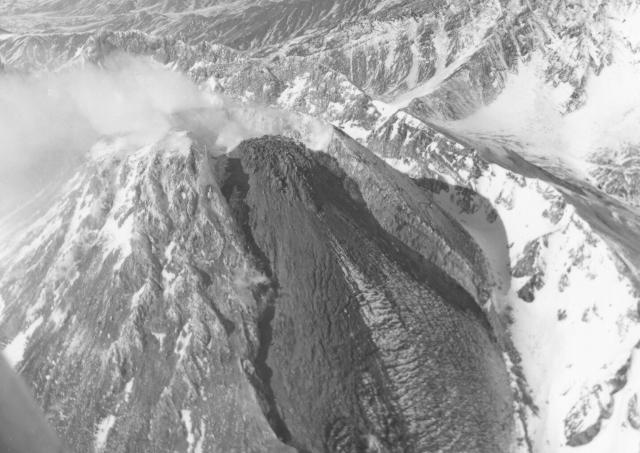Report on Bezymianny (Russia) — April 1988
Scientific Event Alert Network Bulletin, vol. 13, no. 4 (April 1988)
Managing Editor: Lindsay McClelland.
Bezymianny (Russia) Viscous lava extrusion
Please cite this report as:
Global Volcanism Program, 1988. Report on Bezymianny (Russia) (McClelland, L., ed.). Scientific Event Alert Network Bulletin, 13:4. Smithsonian Institution. https://doi.org/10.5479/si.GVP.SEAN198804-300250
Bezymianny
Russia
55.972°N, 160.595°E; summit elev. 2882 m
All times are local (unless otherwise noted)
"Andesitic dome growth has continued . . . . Since 1977, viscous lava flows have issued from the upper part of the dome. Explosive eruptions have accompanied the dome growth once or twice a year, generating block and ash flows. The strongest post-1956 explosive activity took place in 1985. The E part of the dome collapsed, producing a series of pyroclastic flows that extended as far as 13.5 km. The collapse was accompanied by a small lateral blast. After the explosive activity, extrusion of viscous lava resumed, from a new vent on the dome.
"In 1986, two eruptive episodes generated pyroclastic flows and extrusive activity. The pyroclastic flows advanced as much as 4 km, and the viscous lava flows extruded in 1986 filled a trough formed in the dome during the 1985 activity. Throughout 1987, quiet effusion of viscous lava continued from the upper part of the dome (figure 3). The flows overtopped one another, moved over the filled trough, and advanced to the upper reaches of the eastern avalanche valley."
 |
Figure 3. Oblique aerial view of Bezymianny from the E on 10 March 1987, showing the dome, and lava moving down the upper E flank. Photo by A.B. Belousov. |
Geological Summary. The modern Bezymianny, much smaller than its massive neighbors Kamen and Kliuchevskoi on the Kamchatka Peninsula, was formed about 4,700 years ago over a late-Pleistocene lava-dome complex and an edifice built about 11,000-7,000 years ago. Three periods of intensified activity have occurred during the past 3,000 years. The latest period, which was preceded by a 1,000-year quiescence, began with the dramatic 1955-56 eruption. This eruption, similar to that of St. Helens in 1980, produced a large open crater that was formed by collapse of the summit and an associated lateral blast. Subsequent episodic but ongoing lava-dome growth, accompanied by intermittent explosive activity and pyroclastic flows, has largely filled the 1956 crater.
Information Contacts: G. Bogoyavlenskaya and A.B. Belousov, IV.

